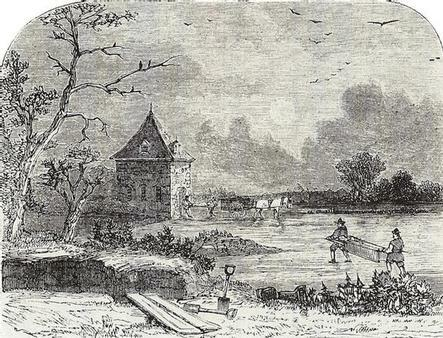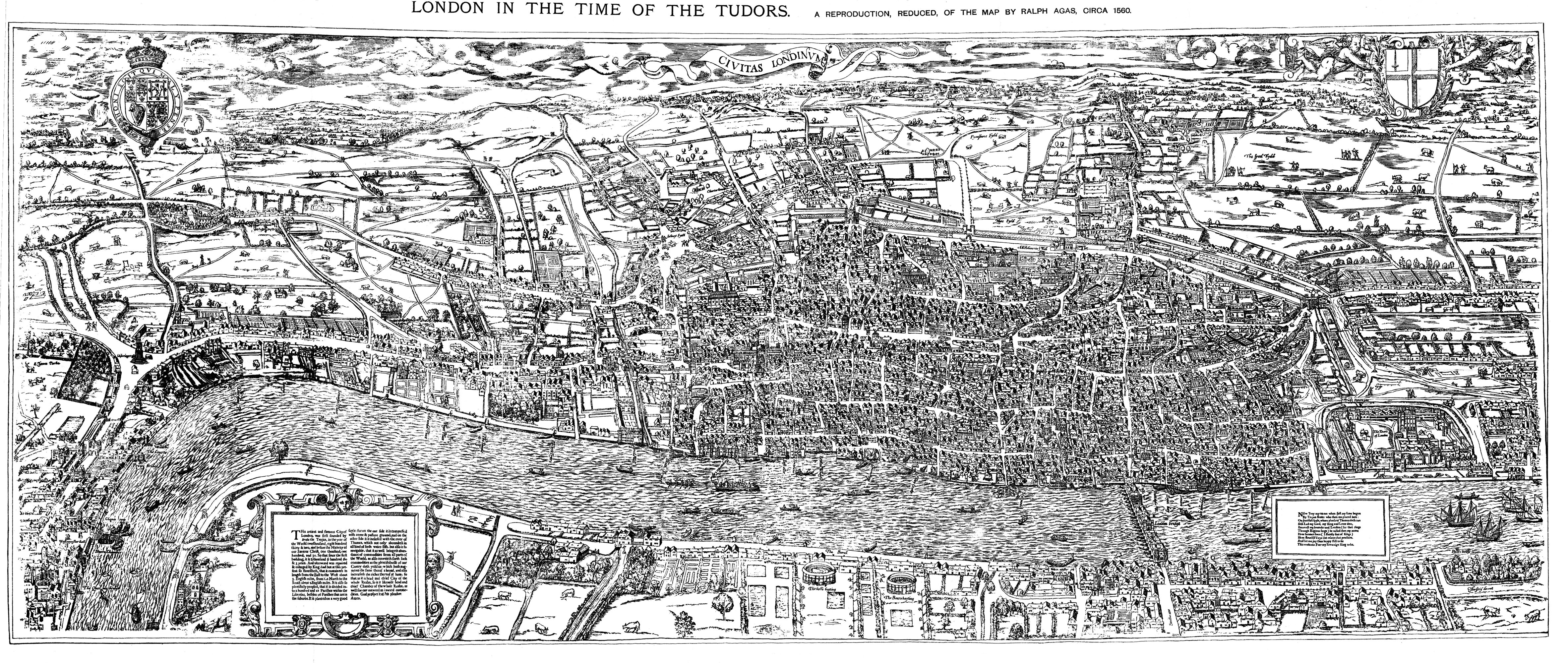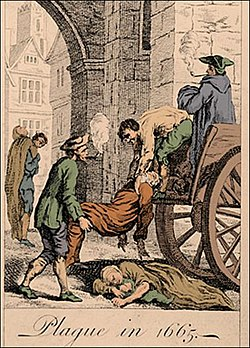created 2025-03-24, & modified, =this.modified
tags:y2025lostpsychogeographyplague
Why I’m reading
Mentioned in Psychogeography by Merlin Coverley as an early psychogeographic text. I want to see this account of a city, under demanding conditions, and where humans might have interacted with the city differently than now.
I’m familiar with Robinson Crusoe but I have no read it.
Daniel Defoe born Daniel Foe; c. 1660 – 24 April 1731) was an English writer, merchant and spy. He is most famous for his novel Robinson Crusoe, published in 1719, which is claimed to be second only to the Bible in its number of translations
O mIsErY We BoTH ShaLL DyE WoE, WoE
Memoirs of the Plague
a blazing Star or Comet appear’d for several Months before the Plague, as did the Year after another, a little before the Fire; … those two Comets pass’d directly over the City, and that so very near the Houses that it was plain, they imported something peculiar to the City alone; that the Comet before pestilence, was of a faint, dull languid Colour, and its Motion heavy, solemn and slow; But that other Comet before the Fire, was bright and sparkling, or as others said flaming and its Motion swift and furious.
Ghosts are believed seen.
Astrologers added Stories of the Conjunctions of Planets in malignant manner, and with a mischievous influence.
Infallible preventative pills, “soveraign cordials” against the corruption of air, the royal antidote, such and more were the new creations to ward off the infection.
- An eminent High Dutch physician, newly come over from Holland, where he resided during all the time of the great plague, and cured multitudes of people that had plague upon them.
- An antient Gentlewoman having practised with great success. She gives her advice only to the female sex.
I can omit subtly of one of those quack-operators, which he gull’d the poor people to croud about him, but did nothing for them without money. He had it seems, added to his Bills, which he gave about the Street, this advertisement in capital letters, He gives Advice to the Poor for nothing
The poor, he gives them advice for nothing, but the cure costs.
The later fire, which consumed all the plague did not touch.
Watchmen: That to every infected House there be appointed to Watchmen, one for every day and the other for the night. And that these persons have a special care that no Persons go in or out of such infected houses, whereof they have the Charge upon severe pain or punishment.
Orders concerning infected houses
- Notice to be given of the sickness
- Sequestration of the sick
- Airing the Stuff
- Shutting up the houses
- None to be removed out of infected houses
- Burial of the Dead
- No infected stuff be uttered
- No person conveyed out of any infected house
- Every visited house to be marked
- Every visited house to be watched
Care to be had of unwholesome Fish or Flesh and of musty Corn.
THAT special care be taken, that no stinking Fish, or unwholesome Flesh, or must be Corn or other corrupt Fruits of what sort soever be suffered or sold throughout the city.
Several people got out of their houses by bribing the watchmen, and giving them money to go out privately in the night.
Observations:
- The plague generally came to the houses by means of the servants, who were obliged to send p and down the street for necessities, meet with distempered people who conveyed the fatal breath
- It was a mistake that there was only one Pest-house (place for isolating of the plagued and otherwise contagious)

- The calamity spread by infection, by some certain steams or fumes which the physicians call Effluvia by the breath, or by the sweat or stench of sores of the sick persons. I look upon with contempt the as the effect of manifest ignorance and enthusiasm, likewise the opinion of others who talk of infection being carried by the Air only, by carrying its vast Numbers of insects or invisible creatures who enter the body by breath, or every at the pores with the air, and there generate and emit the most acute poisonous ovae or eggs which mingle themselves with blood, and so infect the body.
Theories - By Breath, or by insects, or by heavenly decree.
I could tell here dismal stories of living infants being found sucking the breasts of their mothers or nurses, after they have been dead of the plague.
I have heard also of some, who on the Death of their relations, have grown stupid with some insupportable sorrow, and of one in particular who was so absolutely overcome with the pressure upon his spirits that by degrees, his head sunk into his body, so between his shoulders that the crown of his head was very little seen above the bones of his shoulders, losing by degrees both voice and sense, his face looking forward lay against his collar bone and could not be kept up otherwise, unless held up by the hands of other people; and the poor man never came to himself again, but languished a year in this condition, and died: nor was he ever once seen to lift up his eyes, or to look upon any particular object.
Ordered to kill all dogs and cats, apt to run from house to house. They talked of 40K dogs a five times as many cats lost.
the best physick against the plague is to run away from it.
NOTE
In the back of this edition there is a section, one with a physician’s letters and the other a quack. Excluding record of the Quack here. It is easy fixes, prices and where to find them.
The physician provides a grim listing of symptoms.
From the Physician at Aix
The contagious distemper, which has become the reproach of our faculty here for a month past, is more violent than at Marseilles; it breaks out in carbuncles, Buboes, livid Blisters and purple Spots; the first symptoms are grivous paints in the head, consternations, wild looks, trembling voice, a cadaverous face, a coldness in all extreme parts, a low unequal pulse, great pains of the stomach, reachings to vomit, followed by sleepiness, delirium, convulsions, fluxes of blood.
Most fall into a dreadful phrenzy, so that we are forc’d to tie them.
The Great Plague of London
NOTE
Following text, some brief interesting notes from wikicrawl.
Lasted from 1665 to 1666, and the most recent epidemic of the bubonic plague
Killed an estimated 100,000 people - almost a quarter of London’s population – in 18 months.
The plague was caused by the Yersinia pestis bacterium, which is usually transmitted to a human by the bite of a flea or louse.
London at that time was a city of about 448 acres surrounded by a city wall that had originally been built to keep out raiding bands, and, in the south, by the River Thames.

In late 1664 a bright comet was seen over the sky, and people wondered what it portended.
The density of organisms (humans, other non-human animals) produced filth which was carried out on the street. Overcrowding in the poorer districts made it difficult to maintain. The city employed Rakers filth carriers to place filth outside the walls, which accumulated.
Nosegay
The stench was overwhelming, and people walked around with handkerchiefs or nosegays pressed against their nostrils.
Nosegays were small flower bouquet, a nose ornament literally.
As the poor walked, drain water would be tossed up by vehicles, slop and water from overhanging roofs splashed them.
It is now believed that human body lice also played a key role in causing infections, perhaps more so than rats.
Searcher of the Dead
Searchers of the dead, also known as plague-searchers or simply searchers, were people, mostly women, hired by parishes in London, England, to examine corpses and determine the cause of people’s deaths.
In general, poor, older women who did not care for the sick in other capacities such as midwifery were assigned to the task of “searching”. Searchers were sometimes coerced or bribed to mask patients’ causes of death. Pressure from family members and others in the household would ask that the deaths of those affected would be attributed to alternative, less severe diseases than the plague in order to avoid the inconvenience of quarantine put on houses of those who had passed from the deadly disease.
Analysis of the Bills of Mortality during the months plague took hold shows a rise in deaths other than by plague well above the average death rate, a tell-tale sign of misrepresentation of the true cause of death.
Quarantine
A 40 day quarantine was placed on afflicted houses, without allowance for leaving nor entering. This frequently lead to the death of other inhabitants, by neglect if not from the disease.
A plague house was marked with a red cross on the door and with the words ”Lord have mercy upon us” as a Watchman stood guard outside.
Flight
The rich ran away, including King Charles II of England, his family and his court. Defoe wrote “Nothing was to be seen but wagons and carts, with goods, women, servants, children, coaches filled with people of the better sort, and horsemen attending them, and all hurrying away”
It as more difficult for the poor to move, despite being alarmed by the contagion as their accommodations and livelihoods were in London. Before exiting the gates they required a bill of good health, which was difficult to obtain.
Height
In the last week of July the Bill of Mortality showed 3,014 deaths. Drivers of dead-carts travelled the streets calling “Bring out your dead” and carted away piles of bodies. The authorities became concerned that the number of deaths might cause public alarm and ordered that body removal and interment should take place only at night.
As time went on, there were too many victims, and too few drivers, to remove the bodies which began to be stacked up against the walls of houses.
Plague doctors traversed the streets diagnosing victims, many of them without formal medical training.
On the culling of dogs and cats: this decision may have extended the length of the epidemic since those animals could have helped keep in check the rat population carrying the fleas which transmitted the disease.
Prevention of Spread
The outbreak was concentrated in London, but it affected other areas as well. Perhaps the best known example occurred in the village of Eyam in Derbyshire. The plague allegedly arrived with a merchant carrying a parcel of cloth sent from London. The villagers imposed a quarantine on themselves to stop the further spread of the disease. This prevented the disease from moving into surrounding areas, but around 33% of the village’s inhabitants died over a period of fourteen months
Great Fire of London
That September, the Great Fire of London destroyed much of the City of London, and some people believed that the fire put an end to the epidemic. It is now thought that the plague had largely subsided before the fire took place. Most of the later cases of plague were found in the suburbs, and it was the City of London that was destroyed by the fire.
Plague pits have been archaeologically excavated during underground construction work. Between 2011 and 2015, 3,500 burials from the ‘New Churchyard’ or ‘Bethlam burial ground’ were discovered during the construction of the Crossrail railway at Liverpool Street. Yersinia pestis DNA was found in the teeth of individuals found buried in pits at the site, confirming they had died of bubonic plague.[
